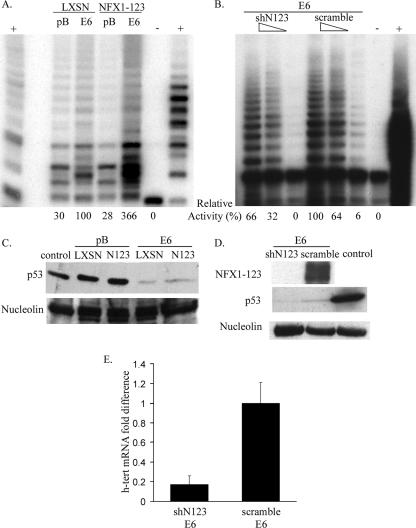FIG. 2.
NFX1-123 affected hTERT mRNA levels and telomerase activity. (A) TRAP assay of HFKs expressing HPV16 E6 (E6) and NFX1-123 or vector controls, LXSN and pB. Telomerase activity was seen in cells expressing HPV16 E6, and NFX1-123 increased that activity by more than threefold. Two micrograms of protein lysate was used for each sample. −, negative control, CHAPS {3-[(3-cholamidopropyl)-dimethylammonio]-1-propanesulfonate} lysis buffer; +, positive controls, telomerase plus cells and TSR8 synthetic template for PCR. (B) TRAP assay of HFKs expressing HPV16 E6 (E6) and shRNA against NFX1-123 (shN123) or scramble oligonucleotide as a control (scramble). Telomerase activity was reduced in cells with knockdown NFX1-123 protein. One microgram, 0.5 μg, and 0.1 μg of protein lysate were used for each sample. −, negative control, CHAPS lysis buffer; +, telomerase plus cells. (C) Western blots of cell lysates used in panel A. Expression of HPV16 E6 (E6) degraded p53 compared to vector control cells (pB) and uninfected HFKs (control). Nucleolin is shown as a loading control. (D) Western blots of cell lysates used in panel B. Expression of HPV16 E6 (E6) degraded p53 compared to uninfected HFKs (control), and shRNA against NFX1-123 (shN123) knocked down protein levels in HFKs compared to the scrambled oligonucleotide (scramble). Nucleolin is shown as a loading control. (E) Real-time PCR of NFX1-123 knockdown cells showed an 80% reduction in endogenous hTERT mRNA levels compared to scramble control cells. Error bars, 95% confidence interval. All films were scanned in through Adobe Photoshop.

